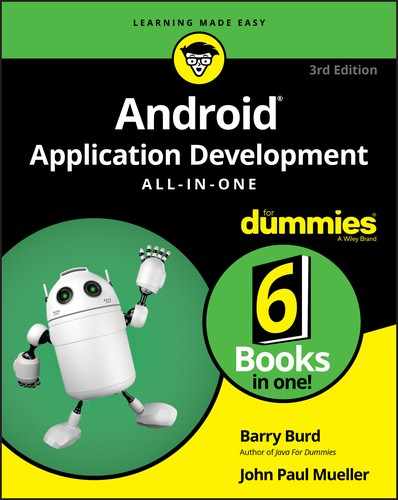Book Description
Conquer the world of Android app development
Android has taken over the mobile and TV markets and become unstoppable! Android offers a vast stage for developers to serve millions—and rake in the profits—with diverse and wide-ranging app ideas. Whether you’re a raw recruit or a veteran programmer, you can get in on the action and become a master of the Android programming universe with the new edition of Android Application Development For Dummies All-in-One. In addition to receiving guidance on mobile and TV development, you’ll find overviews of native code, watch, car, Android wear, and other device development.
This friendly, easy-to-follow book kicks off by offering a fundamental understanding of Android’s major technical ideas, including functional programming techniques. It moves on to show you how to work effectively in Studio, program cool new features, and test your app to make sure it’s ready to release to a waiting world. You’ll also have an opportunity to brush up on your Kotlin and develop your marketing savvy. There are millions of potential customers out there, and you want to stand out from the crowd!
- Understand new features and enhancements
- Get development best-practices
- Know your Android hardware
- Access online materials
With a market share like Android’s, the stakes couldn’t be higher. Android Application Development For Dummies All-in-One levels the field and gives you the tools you need to take on the world.
Table of Contents
- Cover
- Introduction
- Book 1: Getting Started with Android Application Development
- Book 2: Android Background Material
- Chapter 1: Using Android Studio
- Chapter 2: Kotlin for Java Programmers
- Chapter 3: Kotlin for Everyone
- Chapter 4: What Kotlin Does (and When)
- Chapter 5: Object-Oriented Programming in Kotlin
- Chapter 6: Functional Programming in Kotlin
- Defining Functional Programming
- Understanding Pure and Impure Languages
- Comparing the Functional Paradigm
- Using Kotlin for Functional Programming Needs
- Defining the Role of State
- Using Recursion to Perform Calculations
- Using Function Types
- Understanding Function Literals
- Defining the Function Types
- Using Functional Programming for Android Apps
- Chapter 7: A <brief> Look at XML
- Book 3: The Building Blocks
- Book 4: Programming Cool Phone Features
- Book 5: Apps for Tablets, Watches, TV Sets, and Cars
- Book 6: The Job Isn’t Done Until …
- Index
- About the Authors
- Connect with Dummies
- End User License Agreement
